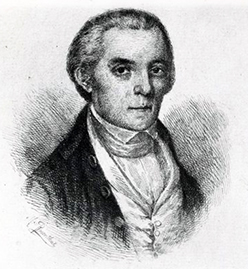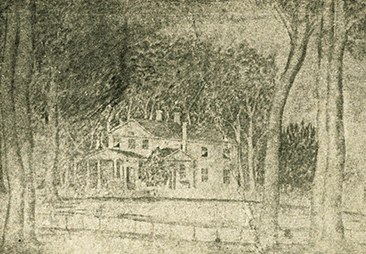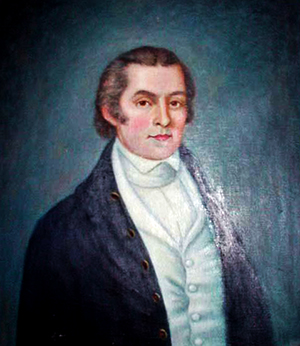25 May 1741–18 June 1801

Willie Jones, Revolutionary patriot, consummate politician, Jeffersonian Democrat, and ardent states' righter, was born in Surry County, Va., of Welsh and English parentage. His father, Robin Jones, was sent to Eton where he is said to have attracted the attention of Earl Granville, who later appointed him as his agent for the province of North Carolina. Robin married Sarah Cobb of York County, Va., in 1737 or 1738. They were the parents of five children, including Willie's prominent, conservative brother, Allen, whose daughter, Sarah, married William Richardson Davie. In the early 1750s Robin Jones and his family moved to present Northampton County, N.C., about six miles from the then thriving and important borough town, Halifax. As Granville's land agent and as attorney general of North Carolina, he was probably the largest landed proprietor on the Roanoke River.
Willie (pronounced Wiley) was named for one of his godfathers, the Reverend William Willie of Albemarle Parish, Va. He and his brother Allen both attended their father's alma mater, Eton, which Willie left in 1758 to make the continental "grand tour." On his return to North Carolina, he found that Allen had built his home, Mount Gallant, on the Northampton side of the Roanoke and that his father had left him his large colonial home, The Castle, three miles south of present Jackson. Preferring to live in Halifax, he is said to have torn down his paternal home and built from these timbers, many of which may have come from England, a new home in the southern end of the town—The Groves, behind which was one of the finest race tracks in the colony. This home (which collapsed in the early 1900s) soon became the council hall of many stirring political meetings and the focal point for the belles and blades of the section—both groups of which sought Halifax as the political and social mecca of northeastern North Carolina.
Despite the imminence of war, Jones married Mary Montfort, the daughter of Colonel Joseph Montfort, appointed by the Duke of Beaufort as the first and only "Grand Master of Masons of and for America." Willie and his wife had thirteen children, only five of whom lived to maturity. Of those who survived, two were sons who died unmarried. Thus there was not one to carry on the name of Jones. The three daughters who lived to maturity all married. Anna Maria married Joseph B. Littlejohn, who served as secretary to William R. Davie on the French mission of 1800. Martha (or Patsy) married U.S. Senator John Wayles Eppes of Buckingham County, Va., whose first wife was Maria, daughter of Thomas Jefferson. The third daughter, Sally Welch, married, first, Hutchins G. Burton, later governor, and second, Andrew Joyner of Poplar Grove near Weldon, N.C.

Willie Jones lived the life of a typical aristocratic planter of the times. According to the records of 1790, he owned, in District 9 of Halifax County alone, 9,942 1/2 acres and 120 slaves, being one of the largest slaveholders in the state; his brother Allen owned 170 slaves. His first political venture was at age twenty-six when he represented Halifax County in the House of Commons in 1767, followed by another session in 1771. As might be expected from his heritage, he was identified during these early years with the royal governors, William Tryon and Josiah Martin, and their clique. He marched with Tryon's colonial militia to Orange County and was appointed Tryon's aide-de-camp on 15 May 1771, the day before Tryon's victory over the Regulators at the Battle of Alamance. Several days later Captain Jones was sent to raid the plantation of Herman Husband, a leading Regulator. When Tryon left North Carolina to become governor of New York, Jones "publicly lamented his removal . . . as a calamity to the province." As a further indication of his allegiance to the royal clique, he was appointed, on Governor Martin recommendation, to His Majesty's Council of the Province of North Carolina on 9 Mar. 1774.
Jones's apostasy to the Whig cause in the approaching American Revolution was swift. He promptly refused the Council appointment and took his place among the leading radical elements of the Whig faction, which opposed the more conservative elements led by Samuel Johnston, William Hooper, Archibald Maclaine, and Jones's brother, Allen. He was elected to each of the five Provincial Congresses, but could not attend the fourth because he had been appointed superintendent of Indian Affairs for the Southern Colonies. At the Fifth Provincial Congress, he served on the committee to draft the state constitution and has been credited by many as its chief author.
Jones rapidly emerged as the acknowledged leader of the radical, democratic element in the state. He represented the borough of Halifax in the House of Commons in 1777 and 1778 and the county of Halifax in 1779 and 1780. He was senator in 1782, 1784, and 1788. He also served for a year in the Continental Congress (1780).
States' righter that he was, Jones refused appointment as a delegate to the Federal convention in 1787. His excuse to Governor Caswell was that he did not "think it will be in my power to attend there at the Time appointed." When the Constitution was submitted to the Hillsborough convention in 1788, he led the Anti-Federalist forces against its adoption. On the first day he proposed a vote without debate, declaring that "all the delegates knew how they were going to vote and he did not want to be guilty of lavishing public money." Defeated on this issue, he yielded to a full-scale, eleven-day debate in which he seldom participated, but exerted his influence against adoption behind the scenes. Particularly deploring the absence of a bill of rights, he cited a letter from Thomas Jefferson in Paris to James Madison at the Virginia convention, in which Jefferson wrote that he wished nine states would adopt it, not because it deserved ratification but in order to preserve the Union. Jefferson hoped, though, that the other four states would reject it—to ensure the adoption of amendments. Jones, in agreement, concluded: "For my part, I would rather be eighteen years out of the Union than adopt it in its present defective form."
When the final ballot was taken, the Anti-Federalists, by a vote of 184 to 84, carried a resolution neither rejecting nor ratifying the Constitution, but proposed a bill of rights of twenty parts as well as twenty-six amendments. Perhaps realizing that the efforts of such leading Federalists as William R. Davie and James Iredell had turned the tide, Jones did not run as a delegate to the Fayetteville convention of 1789, which ratified the Constitution by a vote of 195 to 77.

North Carolina's entrance into the Union marked Jones's retirement from the political arena, except that in 1796 he ran, and was defeated, for the post of presidential elector. The Jones tradition, however, was carried on by Nathaniel Macon, like Jones a man of aristocratic background imbued with a democratic attitude, who assumed leadership of the Jeffersonian party in the 1790s and held it for over three decades.
Jones's political retirement did not mean that he had forsaken other areas of public service. Not the least of these was his role as "the real founder of Raleigh." He served on the committee, appointed by the legislature in 1791, to locate the capital within ten miles of Isaac Hunter's plantation in Wake County. The committee purchased 1,000 acres of land from Joel Lane and laid off a city containing 400 acres. (It has been suggested that a statue be raised in Raleigh in honor of Jones, who actually parceled out the land. His name and those of other commissioners have been perpetuated in the names of the city's streets.) Soon afterwards he bought sixteen one-acre lots and later built a summer residence, Welcome, where he reportedly spent much of his time.
Still following the Jeffersonian tradition, Jones worked to carry out the constitutional mandate for a state university and served on the original board of trustees. Representing the Halifax judicial district, he also sat on the committees to select the location of the university and to choose its president. After donating $100 to support The University of North Carolina, he and his erstwhile political opponent, William R. Davie, issued a joint appeal in the North Carolina Journal for donations to the institution.
Because of his sympathy for the transmontane frontiersmen, the town of Jonesborough, "the oldest formally established town in Tennessee (1779)," was named for this "warm friend of over-mountain people." It was the first capital of the state of Franklin and is still the seat of Washington County. Also, Jones County in North Carolina was named for him.
The sudden decline in Jones's health was first revealed in a letter of 24 May 1801 from Nathaniel Macon to Thomas Jefferson, in which he wrote: "Your acquaintance, Mr. Willie Jones, is, I fear not long for this world. He is unable to walk, and there is no probability that he ever will again." Within a month Jones died at his seat in Raleigh. The Raleigh Register concluded his obituary with the statement that "it may with the greatest truth be said that Carolina has not produced a son of greater mental endowment than Mr. Jones, no one who lived more universally and deservedly respected or died more affectionately and sincerely regretted." He was buried on land now occupied by St. Augustine's College, but there is no trace of his grave. A search for it made in 1860 by Thomas Sherwood Haywood and others was unsuccessful.
Jones's will is a remarkable document. He directed that, if he died in Halifax, he should be buried beside his little daughter; or, if he died in Raleigh, he should be buried beside another small daughter. Reflecting his deistic philosophy, no monument or tombstone was to be placed over his grave. The will further stated: "No priest or other person is to insult my corpse by uttering any impious observations over my body. Let it be covered sunny and warm and there is an end. My family and my friends are not to mourn my death, even with a black rag—on the contrary, I give my wife and three daughters, Anna Maria, Sally and Patsy, each a Quaker-colored silk, to make their habits on the occasion."
Perhaps no man in North Carolina more aptly exemplified the eighteenth-century concept of noblesse oblige than did Willie Jones. An aristocrat and a man of great wealth, he was no demagogue or office seeker, but was instead a statesman whose guiding principles were the independence of sovereign people and the social and economic well-being of the masses, who looked to him as a father. Ingrained with this concept of service to the state and to the people, he devoted thirty years of his life to the application of this philosophy. A liberal in politics, education, and religion, he was indeed an "aristocratic democratic," cut from the same pattern as Thomas Jefferson.